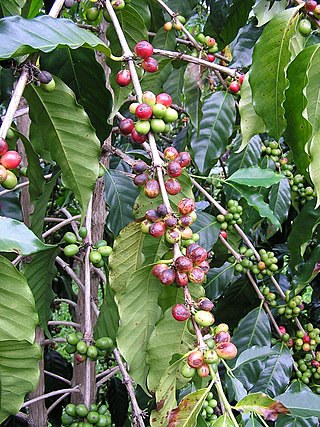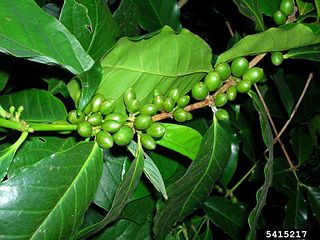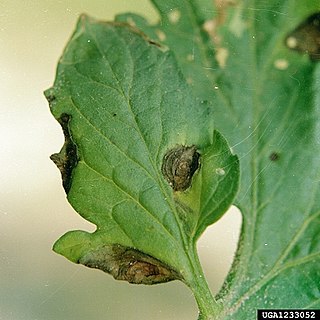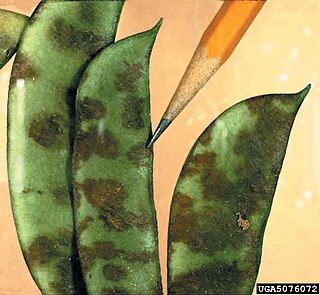
Botrytis cinerea is a necrotrophic fungus that affects many plant species, although its most notable hosts may be wine grapes. In viticulture, it is commonly known as "botrytis bunch rot"; in horticulture, it is usually called "grey mould" or "gray mold".

A plant canker is a small area of dead tissue, which grows slowly, often over years. Some cankers are of only minor consequence, but others are ultimately lethal and therefore can have major economic implications for agriculture and horticulture. Their causes include a wide range of organisms as fungi, bacteria, mycoplasmas and viruses. The majority of canker-causing organisms are bound to a unique host species or genus, but a few will attack other plants. Weather and animal damage can also cause stress to the plant resulting in cankers. Other causes of cankers is pruning when the bark is wet or using un-sterilized tools.

Grape black rot is a fungal disease caused by an ascomycetous fungus, Guignardia bidwellii, that attacks grape vines during hot and humid weather. “Grape black rot originated in eastern North America, but now occurs in portions of Europe, South America, and Asia. It can cause complete crop loss in warm, humid climates, but is virtually unknown in regions with arid summers.” The name comes from the black fringe that borders growing brown patches on the leaves. The disease also attacks other parts of the plant, “all green parts of the vine: the shoots, leaf and fruit stems, tendrils, and fruit. The most damaging effect is to the fruit”.
Glomerella graminicola is an economically important crop parasite affecting both wheat and maize where it causes the plant disease Anthracnose Leaf Blight.

Mycosphaerella coffeicola is a sexually reproducing fungal plant pathogen. It is most commonly referred to as the asexual organism Cercospora coffeicola.

Colletotrichum kahawae is a fungal plant pathogen that causes coffee berry disease (CBD) on Coffea arabica crops. The pathogen is an ascomycete that reproduces asexually. The asexual spores (conidia) are stored within acervuli. This disease is considered to be one of the major factors hampering C.arabica production in the African continent, which represents the current geographic range of the fungus. Coffee berry disease causes dark necrosis in spots and causes the green berries of the coffee to drop prematurely. High humidity, relatively warm temperatures, and high altitude are ideal for disease formation. Given the severity of the disease and the lack of effective control measures, there is great concern that the fungus may spread to other coffee producing continents, such as South America, which could have catastrophic consequences.

Diplocarpon earlianum is a species of fungus that causes disease in strawberry plants called strawberry leaf scorch. The disease overwinters in plant debris and infects strawberry plants during the spring season when it is wet. The five main methods to reduce strawberry leaf scorch include: irrigation techniques, crop rotation, planting resistant and disease-free seeds, fungicide use, and sanitation measures. Control of strawberry leaf scorch is important because it is responsible for the majority of disease in strawberries. Diplocarpon earliana affects the fruit quality and yield of the strawberry crop. Losses range from negligible to severe depending on numerous epidemiological factors including cultivar susceptibility, type of cropping system, and weather conditions

Alternaria solani is a fungal pathogen that produces a disease in tomato and potato plants called early blight. The pathogen produces distinctive "bullseye" patterned leaf spots and can also cause stem lesions and fruit rot on tomato and tuber blight on potato. Despite the name "early," foliar symptoms usually occur on older leaves. If uncontrolled, early blight can cause significant yield reductions. Primary methods of controlling this disease include preventing long periods of wetness on leaf surfaces and applying fungicides. Early blight can also be caused by Alternaria tomatophila, which is more virulent on stems and leaves of tomato plants than Alternaria solani.
Bipolaris cactivora is a plant pathogen causing cactus stem rot and pitaya fruit rot.

Didymella bryoniae, syn. Mycosphaerella melonis, is an ascomycete fungal plant pathogen that causes gummy stem blight on the family Cucurbitaceae, which includes cantaloupe, cucumber, muskmelon and watermelon plants. The anamorph/asexual stage for this fungus is called Phoma cucurbitacearum. When this pathogen infects the fruit of cucurbits it is called black rot.
Colletotrichum capsici is a species of fungus and plant pathogen which causes leaf blight on Chlorophytum borivilianum, basil, chickpea and pepper as well as dieback in pigeonpea and anthracnose in poinsettia.

Colletotrichum coccodes is a plant pathogen, which causes anthracnose on tomato and black dot disease of potato. Fungi survive on crop debris and disease emergence is favored by warm temperatures and wet weather.

Colletotrichum lindemuthianum is a fungus which causes anthracnose, or black spot disease, of the common bean plant. It is considered a hemibiotrophic pathogen because it spends part of its infection cycle as a biotroph, living off of the host but not harming it, and the other part as a necrotroph, killing and obtaining nutrients from the host tissues.

Glomerella cingulata is a fungal plant pathogen, being the name of the sexual stage (teleomorph) while the more commonly referred to asexual stage (anamorph) is called Colletotrichum gloeosporioides. For most of this article the pathogen will be referred to as C. gloeosporioides. This pathogen is a significant problem worldwide, causing anthracnose and fruit rotting diseases on hundreds of economically important hosts.
Colletotrichum fragariae is a fungal plant pathogen infecting strawberries. It is not a well known fungus, and there are many similar fungi that are related to it. It is part of the Colletotrichum genus. It is a pathogen that occurs in strawberries. It leads to the disease known as anthracnose. This is typically at the crown of the strawberry, which is why it is often called crown rot. It is also known as the Anthracnose Crown rot. The fungus also infects leaves and is known as leaf spot, which is common among all Colletotrichum. This is not as common in the fragariae, as it is more common in the crown. This fungus is also better at infecting younger strawberries/seedlings. The most common way to control this disease is fungicides that are harmful to the environment. There have been studies done to see if the fungus infects other hosts but other than some weeds, it is very specific to Strawberries.
Colletotrichum cereale is a plant disease (fungus) that has been found to cause crown rot anthracnose of turf grass most commonly occurring on golf courses. Anthracnose can occur as both a foliar blight and basal rot. This disease attacks the crowns of plants, which is different than other anthracnose diseases. Anthracnose of turfgrass can be a foliar disease or in this case a basal rot of the lower portion of the plant. It attacks different species of turfgrass throughout the world most commonly annual bluegrass and creeping bentgrass.
Pecan anthracnose is a fungal disease of pecan trees caused by the ascomycete Glomerella cingulata (Stoneman) Spauld. & H. It is a widespread disease found wherever pecan trees are grown. Pecan anthracnose has been reported as far back in time as 1914, and as far away as Argentina. Glomerella cingulata has two anamorphs which cause disease on pecan trees, Colletotrichum gloeosporioides and Colletotrichum acutatum. The occurrence of Colletotrichum on pecans has contributed to a significant decline in pecan production in various years. An increase in the incidence of pecan anthracnose is highly correlated with heavy rainfall, especially heavy rainfall occurring in early spring. The severity of symptoms increases as the season progresses, often culminating in leaf drop in the late autumn. This defoliation is linked to lower yield and poorer quality of nuts.

Raspberry spur blight is caused by the fungus Didymella applanata. This plant pathogen is more problematic on red raspberries (Rubus idaeus) than on black or purple raspberries. The fungus infects the leaves first and then spreads to the cane. It causes necrotic spots on the cane near the base of the petiole attachment. Raspberry spur blight can cause a significant reduction in yield, fruit blight, premature leaf drop, and weak bud and cane growth. The magnitude of damage is not clearly understood in the United States, however, studies from Scotland suggest damage to the cane itself is limited. The disease has minor economic impacts by reducing leaves in the summer or killing buds. Major economic damage occurs if the disease manages to kill the entire cane. In the United States, this disease is found in Oregon and Washington.

Common spot of strawberry is one of the most common and widespread diseases afflicting the strawberry. Common spot of strawberry is caused by the fungus Mycosphaerella fragariae. Symptoms of this disease first appear as circular, dark purple spots on the leaf surface. Mycosphaerella fragariae is very host-specific and only infects strawberry.

Bitter rot of apple is a fungal disease of apple fruit that is caused by several species in the Colletotrichum acutatum and Colletotrichum gloeosporioides species complexes. It is identified by sunken circular lesions with conical intrusions into the apple flesh that appear V-shaped when the apple is cut in half through the center of the lesion. It is one of the most devastating diseases of apple fruit in regions with warm wet weather.














